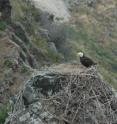Bald eagle diet shift enhances conservation
An unprecedented study of bald eagle diet, from about 20,000 to 30,000 years ago to the present, will provide wildlife managers with unique information for reintroducing Bald Eagles to the Channel Islands off California. The scientists, including researchers from the Carnegie Institution's Geophysical Laboratory, found that eagles fed mainly on seabirds from about 20,000 to 30,000 years ago to the 1840s and 50s, when humans introduced sheep. The seabirds provided an abundant source of carrion for the local eagle population until the pesticide DDT wiped out the eagles in the 1960s. The results are published in the online early edition of the Proceedings of the National Academy of Sciences USA the week of May 3, 2010. "Reintroducing bald eagles to the Channel Islands has had mixed results," remarked lead author Seth Newsome, a postdoctoral researcher at Carnegie at the time of the study.* "An understanding of their diet is critical to successful reintroduction, so we looked for chemical traces of the foods the eagles consumed over many millennia. Since bald eagles are extremely opportunistic, they can quickly adapt to changes in the prey base of the diverse ecosystems they inhabit. Because there are no sheep on the islands today and the seabird populations are diminished, we think that the introduced eagles could scavenge seal or seal lion carrion, exert predation pressure on a threatened but recovering local seabird population, or even prey on the endangered island fox."
"Each of these sources has its challenges for wildlife managers," Newsome continued. "Several studies have shown that seals and sea lions are contaminated with pollutants, and a growing bald eagle population could potentially exert significant predation pressure on the fragile fox and seabird populations."
The scientists used a technique called stable isotope analysis of eagle bone and feather remains primarily from a historic nest on San Miguel Island that has been occupied for over 100 years before its abandonment in the mid-20th century. The also examined prehistoric material from paleontological sites from the late Pleistocene on San Miguel Island and material collected during the historic period (1850-1950) from other Channel Islands and the southern California mainland.
Atoms of elements such as carbon and nitrogen, which cycle through the food chain, come in different forms, or isotopes that have the same number of protons, but different numbers of neutrons. Scientists can distinguish them by the tiny differences in their masses.
As it turns out, marine and terrestrial prey have different amounts of the isotopes carbon-13 (13C) and nitrogen-15 (15N). The coastal marine ecosystems in California have higher amounts of 13C and 15N than adjacent terrestrial ecosystems. The marine ecosystems also have more steps in the food chain than the terrestrial ecosystems, resulting in higher amounts of 15N. Since sheep and fox have different isotope ratios compared to seabirds and fish, the researchers could determine the diets of bald eagles by analyzing the isotopes found in their remains.
Source: Carnegie Institution
Other sources
- Bald eagles in Channel Islands might start eating endangered wildlife, researchers sayfrom LA Times - ScienceTue, 4 May 2010, 7:00:46 UTC
- Bald eagle diet shift enhances conservation, study findsfrom Science DailyTue, 4 May 2010, 3:21:47 UTC
- Observatory: A Quandary in Restoring Bald Eagle Populationsfrom NY Times ScienceTue, 4 May 2010, 0:50:20 UTC
- Bald Eagles May Have to Eat Toxic Seals, Study Saysfrom National GeographicMon, 3 May 2010, 22:40:45 UTC
- Bald Eagle Comeback Could Come at Expense of Other Speciesfrom Science NOWMon, 3 May 2010, 21:40:35 UTC
- Eagles' homecoming may harm fragile ecosystemfrom CBC: Technology & ScienceMon, 3 May 2010, 20:10:51 UTC
- Bald eagle diet shift enhances conservationfrom PhysorgMon, 3 May 2010, 19:00:28 UTC
